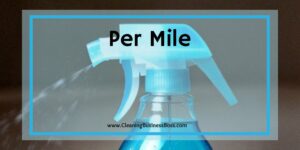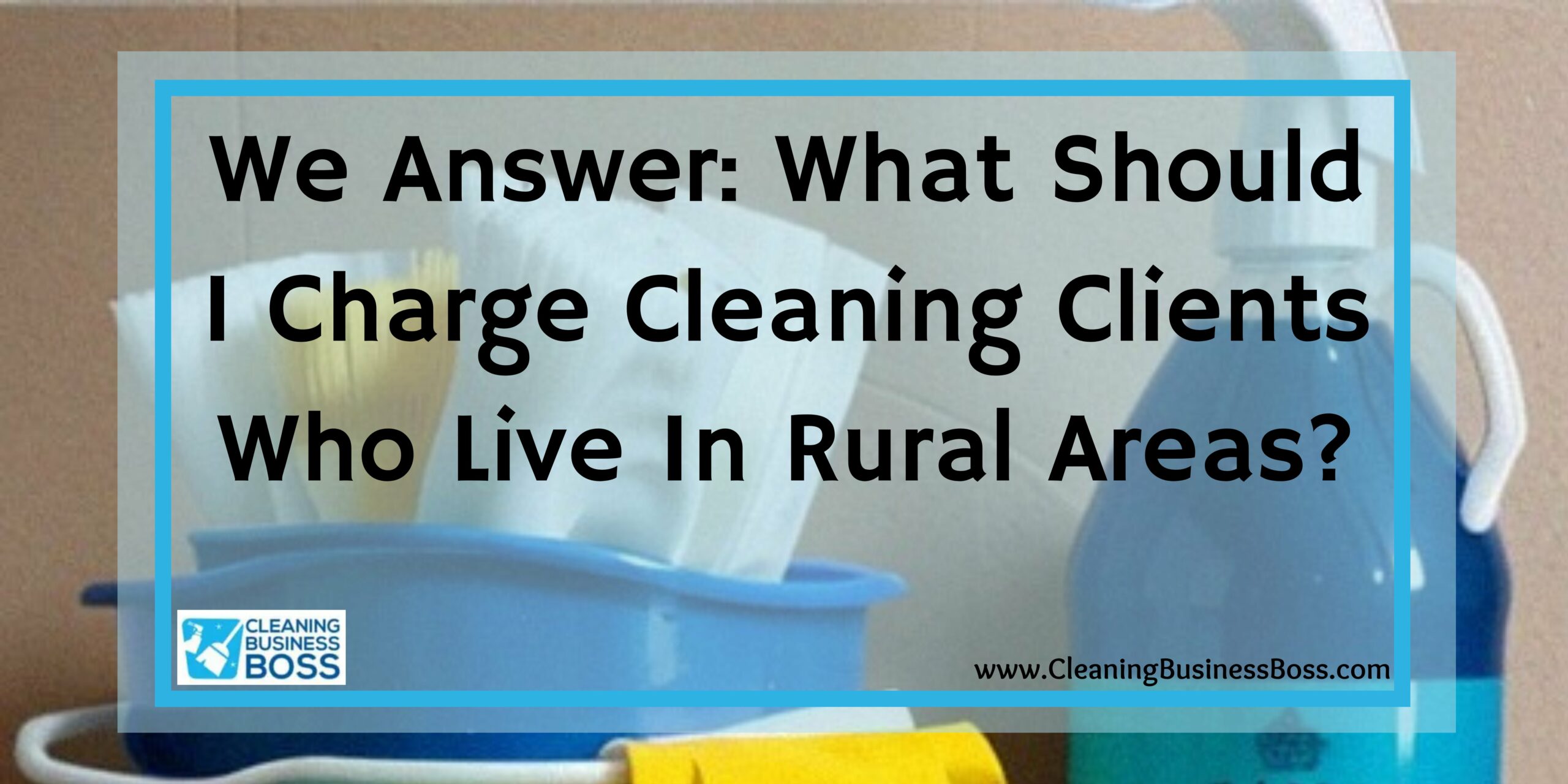Charging clients the correct rate for your cleaning services can be the difference between a profitable business and a business going under.
To come up with an accurate pricing strategy for rural cleaning clients, you need to consider:
- Travel Time
- Cleaning Time
- Your Hourly Rate
- Supplies
- Pricing Model
- Providing Quotes
Travel Time
Travel time is the most important expense consideration when it comes to servicing rural clients. Gas, wear and tear on your vehicle, and time spent traveling instead of servicing clients are all expenses that affect your bottom line.
There are a number of different ways you can charge your clients for your travel time. We will go over these options so you can choose what works best for you.
Flat Hourly Rate
Charging a flat hourly rate for travel is easy to track and easy for the customer to understand what they’re being charged for. The hourly rate should at the bare minimum cover gas expenses. If you want to be a little bit more precise you can add in depreciation on your vehicle and the value of your own time.
A good rule of thumb is anywhere between ¼-½ of what your typical hourly rate is.
Example:
Hourly rate = $75
Travel hourly rate = $20
30 minute travel time (15 miles) = $10 charge
For a 30 minute drive, you are unlikely to travel more than 15 miles. If gas is $3.00/gal you are more than covered for gas and can put the rest towards potential vehicle repairs.
These numbers are flexible and should be adjusted as you understand what an acceptable rate for your customers is.
You can also take a look at your competitors to see what they are charging and either match theirs or go lower to increase the perceived value for your customer.
Per Mile

Another fairly standard way to charge is on a per-mile basis. The IRS standard rate for business miles is 57.5 cents per mile. Given our previous example:
Travel rate = 57.5 cents per mile
15 miles traveled = $8.62 charge
Charging per mile can be advantageous when servicing rural clients because you likely won’t be stuck in traffic. For example:
57.5 cents per mile * 60 mph = $34.5/hr
57.5 cents per mile * 20 mph = $11.50/hr
As your average speed increases, the more efficient your mileage reimbursement will be. This doesn’t mean you should be driving 100 mph to every appointment, but it is something to be aware of if there is a concern for traffic delays.
Check out this article to learn how you can price a house cleaning job.
Staggered Flat Rate
This is another good option for rural clients. This model charges the customer a flat rate fee based on how far they are from your location. For example:
<5 miles = Free
5-15 miles = $8
15+ = $15
The reason this is a useful model for rural clients is that you can get a pretty good estimate of how long a 10-mile drive in the countryside will take compared to a large city with a lot of traffic.
Offer “Free” Travel
Similar to online retailers offering free shipping, you can offer “free” travel. If you choose this option you need to make sure you are factoring the travel costs into your overall price. This can be a good marketing tool if your competitors in the area are charging expensive travel rates.
Your price will likely be a little bit higher than your competitors, but if you promote free travel costs, it could be exactly what your customers want.
The other benefit of this method is your customer doesn’t see the actual travel rate. Some customers may think paying for your travel time is ridiculous and will look for other options.
When you advertise your travel time as free, your customer will feel like you are doing them a favor.
Cleaning Time

How long it takes you to clean property is another important factor in providing a fair but profitable rate for your customers. In order to be accurate with your estimates, you should have an understanding of how long it takes you to perform each service.
Some typical services that you should have standard cleaning times are:
- Common areas
- Kitchen
- Bathroom
- Bedroom
- Patio/deck
- Windows
- Stairs
Example:
The customer has a 3 bedroom 2 bath house and wants a basic cleaning.
- Bedroom – 15 minutes x 3
- Bathroom – 20 minutes x 2
- Kitchen – 20 minutes
- Living room – 20 minutes
- Stairs/misc – 30 minutes
- Total = 2 hours and 35 minutes
Once you have your overall time you can get your potential clients quick and reliable quotes.
It is important that you are very descriptive about what is included (or not) with each service. If you are vague in your description your customer might have different expectations than what you intend to provide, which can cause confusion and frustration for both parties.
Another problem with not being descriptive is that your customer might try to get more than what they paid for. If you don’t have this clearly stated on your website or marketing material, you will likely need to perform extra service in order to keep your customer or avoid a bad review.
Your Hourly Rate
Developing an accurate hourly rate gives you a clear idea of how much it costs you to clean a certain property, and how much you need to charge to make a living.
A good place to start is to look at your competitors’ rates. This gives you an idea of where you need to be to stay competitive. It also gives you a look at some things that you could include in your business and some areas where you could perhaps improve upon their model.
One more advantage of scouting your competition that is it gives you an understanding of the local economy. This is especially important when you are servicing rural communities. Every town is a little different economically.
You can also adjust your hourly rate for the type of service you are performing. You would probably charge more for cleaning out an old, grease-filled oven than you would for basic cleaning.
It is very important that you refine your hourly rate as your business evolves. If your pricing strategy is to go $5/hr less than your competitors, you could find yourself not making enough money to cover your expenses and be in a world of hurt.
Understand your expenses and what you need to make a livable wage.
You should have your basic hourly rate posted on your website and literature.
Example: $45/hr for basic cleaning.
Supplies
Supplies are an often overlooked expense that can take away from your profit and leave you wondering why you are barely skating by. Some typical supplies that you need to account for:
- Sponges, scrubbers, and brushes
- Protective equipment (gloves, masks, goggles)
- Broom with dustpan
- Mop with bucket
- Dusting equipment
- Cleaning solutions (multi-surface, glass, wood, bleach)
- Washcloths and paper towels
- Garbage bags
- Vacuum
- Caddy to carry equipment
It is best to track all of your supplies purchases and then break it down by month, week, and hour. This way you can get a rough estimate of how much you need to make from each cleaning to account for supplies.
Example:
- $300/month spent on supplies
- 150 hours worked
- $2/hr for supplies
Pricing Model

Similar to your travel time, there are multiple options for your pricing model, each with their own unique advantages.
Hourly
Charging by-the-hour is the most basic and straightforward way to price your cleaning services. This model protects you from unexpected things that take more time than you were expecting.
The downside of charging by the hour is that customers aren’t 100% sure how long you are going to take, even if you give them an estimate. This makes some customers uneasy, but for the most part, they tend to be fine with this model.
Per Room/Service
This model is almost the opposite of charging hourly.
This model gives clients comfort, knowing what the exact price will be before they purchase your service.
Unfortunately, this also leaves you on the hook for unexpected delays that will cost you time and money.
This model is especially risky for one time, new, or infrequent customers because you aren’t sure what the condition of the property is and if it will have more unknown surprises.
Assuming our hourly rate is $45/hr, we can use our cleaning times to get a pretty quick estimate of how long each room would take.
- Common areas (20 minutes) = $15 per room
- Kitchen (20 minutes) = $15 per room
- Bathroom (20 minutes) = $15 per room
- Bedroom (15 minutes)= $20 per room
- Patio/deck (30 minutes) = $22.50
- Windows (15 miuntes) = $20
- Stairs (20 minutes) = $15
Per Square Foot
This is another model that leaves you somewhat exposed to the unexpected.
However, if you have a lot of clients in similar types of houses this can be a good way to work in some extra profit.
Similar to charging per room, this gives your customer the peace of mind of knowing what their cost is beforehand, which is sometimes enough for them to commit to your service.
Providing Quotes
Once you have all of this information, you can provide reliable quotes to your customer.
For example, A customer has a 4 bedroom, 2 bathroom home. It is 2000 sq ft and is 13 miles from your location.
- Travel rate (57.5 cents per mile) = $7.47
- Cleaning time = 3 hours
- 4 bedrooms X 15 minutes = 1 hour
- 2 bathrooms X 20 minutes = 40 minutes
- Kitchen = 30 minutes
- Living room = 20 minutes
- Misc = 30 minutes
- Hourly rate = $45/hr
- Supplies = $2/hr
- Total = $148.47
Once you have done this a couple of times you will start to understand what pricing model will work best for you. You can combine different pricing models to fit your customer’s needs. For example, you can have a basic cleaning rate for a 3 bedroom 2 bathroom house, with each additional room after costing a flat rate.
The important part is to keep track of your time and expenses to make sure you are charging your customers enough for you to keep your business running.
Resources
- How to Effectively Charge Customers for Travel Time
- 2020 Average Deep Cleaning Cost (with Price Factors)
- 3 Easy Steps to Price Your Cleaning Services Right
- How much should you charge for housekeeping services?
To learn more on how to start your own cleaning business, check out my startup documents here.
Please note that the contents of this blog are for informational and entertainment purposes only and should not be construed as legal advice. Any action taken based on the information provided in this blog is solely at your own risk. Additionally, all images used in this blog are generated under the CC0 license of Creative Commons, which means they are free to use for any purpose without attribution.

About the author. Entrepreneur and Cleaning Business Fan.
Hi! I am Shawn and I am a happy individual who happens to be an entrepreneur. I have owned several types of businesses in my life from a coffee shop to an import and export business to an online review business plus a few more and now I create online cleaning business resources for those interested in starting new ventures. It’s demanding work but I love it. I do it for those passionate about their business and their goals. That’s why when I meet a cleaning business owner, I see myself. I know how hard the struggle is to retain clients, find good employees and keep the business growing all while trying to stay competitive.
That’s why I created Cleaning Business Boss: I want to help cleaning business owners like you build a thriving business that brings you endless joy and supports your ideal lifestyle.


1 thought on “We Answer: What Should I Charge Cleaning Clients Who Live In Rural Areas?”
Comments are closed.